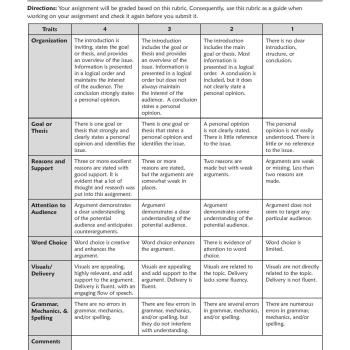Persuasion Rubric

About this printout
Use this rubric to assess the effectiveness of a student's essay, speech, poster, or any type of assignment that incorporates persuasion.
Teaching with this printout
Grading rubrics can be of great benefit to both you and your students. For you, a rubric saves time and decreases subjectivity. Specific criteria are explicitly stated, facilitating the grading process and increasing your objectivity. For students, the use of grading rubrics helps them meet or exceed expectations, to view the grading process as being “fair,” and helps them set goals for future learning.
In order to help your students meet or exceed expectations of the assignment, be sure to discuss the rubric with your students when you assign a persuasion project. It is helpful to show them examples of pieces that meet and do not meet the expectations. As an added benefit, because the criteria are explicitly stated in the rubric, the use of it decreases the likelihood that students will be confused about the grade they receive. The explicitness of the expectations helps students know exactly why they lost points on the assignment and aids them in setting goals for future improvement. Use the Visuals/Delivery category to grade audio and visual elements in speeches, PowerPoint presentations, blogs, posters, skits, podcasts, or any other assignment where visuals and delivery play roles. If your assignment does not require speech or visuals, simply disregard this part of the rubric.
More ideas to try
- Routinely have students score peers’ work using the rubric as the assessment tool. This increases their level of awareness of the traits that distinguish successful persuasive projects from those that fail to meet the criteria.
- Alter some expectations or add additional traits on the rubric as needed. For example, if the assignment is to create a persuasive podcast, criteria such as articulation, communication, sound effects, and audio clarity may be added. You may also adapt the criteria to make it more rigorous for advanced learners and less stringent for lower level learners. In addition, you may want to include content-specific criteria for your subject area.
- After you and your students have used the rubric, have them work in groups to make suggested alterations to the rubric to more precisely match their needs or the parameters of a specific persuasive assignment. For example, if you wanted them to work in cooperative groups to write and present persuasive skits, possible criteria could include teamwork and the length of the skit.